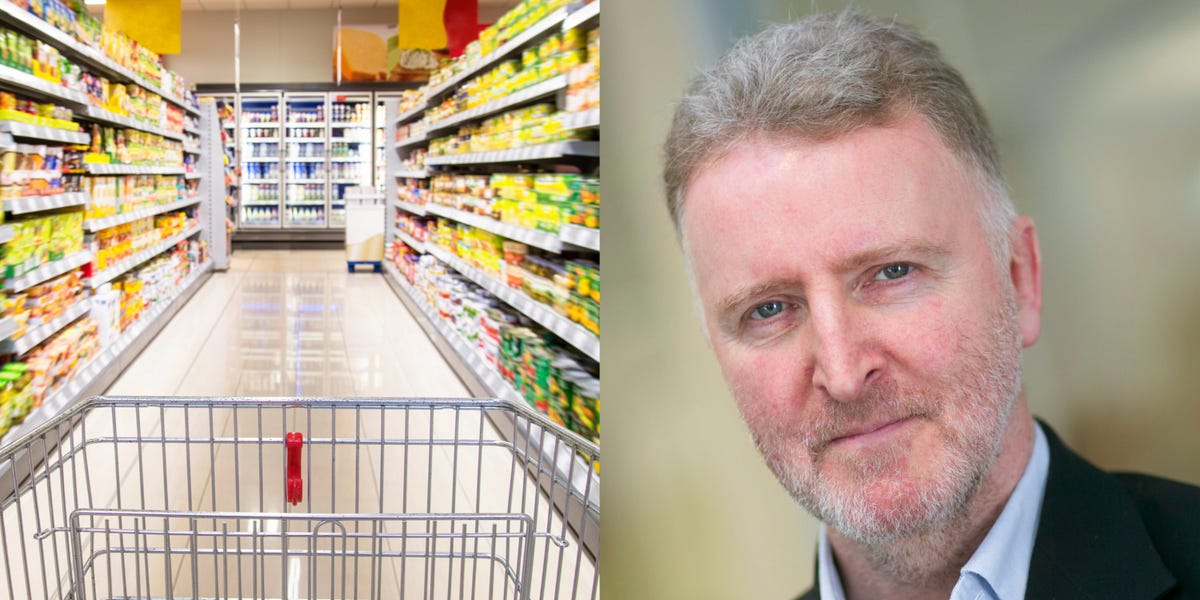- UPFs dominate the Western diet and have been linked to serious health problems, including diabetes.
- Food companies are using sensory scientists to make ultra-processed foods irresistible.
- Sensory expert Professor Barry Smith stopped using UPFs and lost weight effortlessly.
A professor of the senses, who used to help multinational food companies create ultra-processed foods, lost weight effortlessly after cutting processed foods from his diet when he discovered they were harmful to health.
Professor Barry Smith, director of the University of London’s Institute of Philosophy, told Business Insider that he had previously worked with Kellogg’s, Coca-Cola and Ferrero and that UPFs made up around 30 to 40% of his diet.
UPFs, which are made with ingredients and processes not found in a regular kitchen, are a staple of the Western diet, making up 73% of the U.S. food supply, according to a 2024 non-peer-reviewed research paper from Northeastern University’s Network Science Institute.
These super-tasty foods contain the perfect fat-to-carb ratio, making them nearly impossible to stop eating, Smith says.
“These are foods that are so wanted by our system that they slow down our satiety mechanisms,” he said. Research published in Nature Food in 2023 found that the more hyper-palatable foods there were in a meal, the more calories participants ate overall.
Smith started reducing UPFs around 2020 after Dr. Chris Van Tulleken, the author of the bestselling “Ultra Processed People,” which highlights the dangers of industrial food processing, asked him for help on his podcast.
“They wanted to know what sensory tricks and gimmicks go into food production and presentation that make us eat, crave and desire these foods,” Smith said.
It made him more aware of the health issues (a study published in February in The BMJ linked UPFs to a higher risk of 32 health conditions, including type 2 diabetes, depression and cardiovascular disease) and made him think about his work.
“I realized that, without knowing it, I may have been supporting and encouraging these actions of the food industry. I started thinking, no, I can’t do that in good conscience,” he said.
According to Smith, food companies hire sensory scientists and chemists to make their ultra-processed foods irresistible, but the companies themselves often don’t eat the products they help create.
“They know what the design, the make-up, the industrial processing entails. So they don’t necessarily want to eat them themselves,” he said.
Smith no longer works with UPF companies (though he says he’s never given advice on how to make food people can’t leave behind).
He shared three things that helped him change his diet.
Take a Break from UPFs First (And You May Never Go Back)
The more Smith learned about the health risks of UPFs, the less he wanted to eat them, so he decided to eliminate them altogether.
He realized that he didn’t like the physiological effect they had on him, and over time he actually began to hate them.
“They seem too intense, too overpowering in flavor, too flashy in a sense,” he said.
And he found that he felt better. “I purposely cut out ultra-processed foods because of the bad things they could do to my health. And then I found that the effects were so desirable,” he said.
He felt more energetic, fuller for longer, and was able to stop eating when he was full. He also lost weight without trying.
He thinks this is because he was previously addicted to UPFs, rather than actually enjoying them. By stopping for a while, he was able to see them for what they were.
“When you take away that craving, you find that you go back to a very natural intake regulation where you don’t overeat,” Smith said. “It’s not that these are foods that we necessarily like more than anything else, but they are foods that we want and can’t seem to stay away from.”
While it worked for Smith, going cold turkey isn’t for everyone. As registered dietitian Linia Patel previously told BI on the topic of reducing UPFs, creating a new habit involves changing your behavior, so it’s helpful to unpack what works for you.
Check food labels
According to Smith, checking the nutrition labels on foods helps him choose products that are minimally processed.
He has found that even some products you might expect to be “perfectly OK,” like a can of kidney beans from the supermarket, can contain gelling agents or stabilizers. He gets around this by opting for the organic versions.
Unfortunately, this emphasizes that a healthy diet can depend on one’s eating environment and socioeconomic status.
Find really tasty alternatives
As a professor of the senses, Smith is interested in the multisensory experience of tasting. “How things look, how they smell, how they feel on your fingers, even the sound of the food when you break something or when you shake something. All of those things are part of the experience of tasting and eating,” he said.
It’s crucial to keep this in mind when moving away from UPFs that are specifically formulated to be comfortable, he said.
“You’re not going to convince people to switch from ultra-processed foods by telling them it’s bad for them. It has to be the taste first,” he said.
Vegetables, while nutritious, can also be pretty boring, he said. But there are lots of ways to make them interesting, including roasting, pickling and fermenting them.
“You have to make them really tasty so that people realize that I can make something reasonably cheap and reasonably good that I actually like,” he said.
